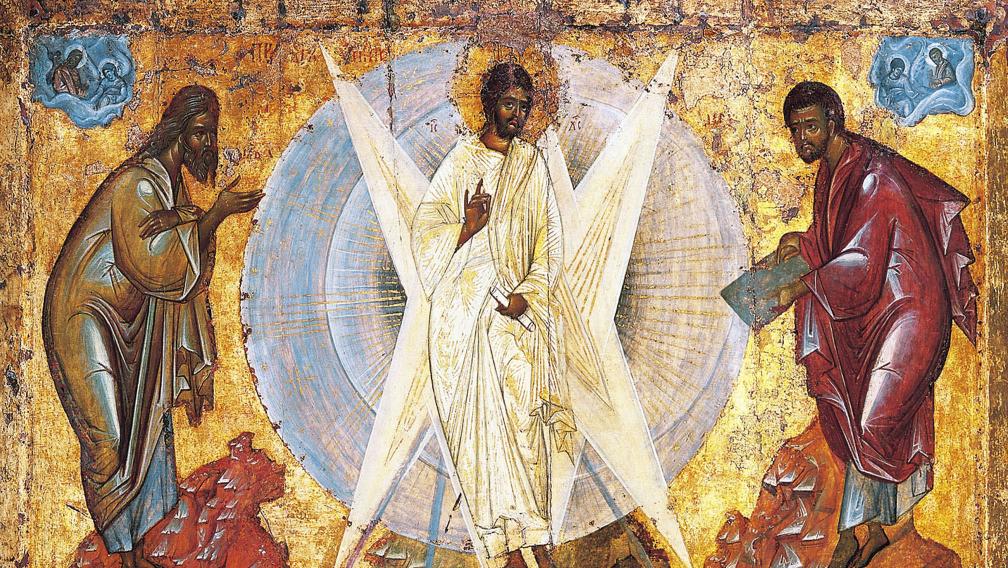Down from the Mountaintop

Jesus took with him Peter and James and John, and led them up a high mountain apart, by themselves. And he was transfigured before them… And there appeared to them Elijah with Moses, who were talking with Jesus. As they were coming down the mountain, he ordered them to tell no one about what they had seen, until after the Son of Man had risen from the dead. —Mark 9:2–9
This is no ordinary mountaintop experience.
In this passage from Mark’s Gospel, the disciples have been following Jesus, a wandering Jewish teacher, for months, and they have seen some amazing things. A paralyzed man has been healed, four thousand people have been fed from a tiny portion of fish and bread, and even Peter (one of Jesus’s closest followers) has seen his own bedridden mother-in-law cured of illness. But nothing could prepare them for what they saw when Jesus asked them to join him on a mountain overlooking the Sea of Galilee.
With the sparkling water far beneath them, they witness Jesus utterly transformed. His clothes shine with an incandescent glow, a thick cloud hovers ominously over the mountain, and a voice thunders above — the very voice of God. To make matters stranger, Moses and Elijah, long-dead prophets, suddenly appear by Jesus’s side.
Their knowledge moves from their heads to their hearts. This is how mountaintop experiences — epiphanies and revelations that open our minds to new realities — change us.
The disciples are rightly terrified. They have never seen anything like this. Pious Jews familiar with the Hebrew scriptures (what Christians call the Old Testament), they are astounded to see these heroes of old, whose stories they heard as children, standing beside Jesus. For them, steeped in a community waiting anxiously for a long-prophesied Messiah, the sudden appearance of these dead prophets could only mean one thing: Jesus is the one they have been waiting for.
The realm of the kingdom of God — the heavenly sphere — is finally breaking into the earthly realm. God is on the move in Jesus.
Coming down the mountain, the disciples are transformed. Their lives have been forever changed by a supernatural reality they had previously only read about. Their knowledge moves from their heads to their hearts. This is how mountaintop experiences — epiphanies and revelations that open our minds to new realities — change us. We come to understand the mystery of God in a new way, and by comparison the miracles we experienced before seem ordinary.
Even Jesus has to come down from the mountaintop. He and his disciples continue their work — feeding the poor, healing the sick, and spreading the good news of God’s love in the world.
We must do the same. Like Jesus’s disciples, we must bring the mountaintop with us into the world below.
Here are more ways to think about how mountaintop experiences transform our understanding of God and shape us for continued good work in a hurting world.
Visual Art
This 15th-century icon of Jesus’s transfiguration by Theophanes the Greek captures the astonishment of the three disciples, who hide their faces in awe.
Theology
The story of Jesus’s transfiguration in the New Testament contains echoes of the story of Moses’s epiphany on Mount Sinai. Rabbi Ismar Schorsch reminds us “the external is only a reflection of a reality that is internal,” showing us how Moses’s mountaintop experience was life-changing from the inside out.
Poetry
Poet and priest Malcom Guite teaches us to look for a “glimpse of how things really are” in “Transfiguration.”
Justice
The Rev. Cassandra Henderson writes about transfiguration in light of her work as a volunteer in adult and child correctional facilities: “While it is easiest to place our own piety at the forefront, Lent must compel and propel us into public witness. At the end of 40 days, Jesus did not walk away to live a private life. Instead, he returned to the world better prepared to be an active agent in its transformation.”
Music
With soaring voices, the Saint Thomas Choir of Men and Boys considers “The Transfiguration.”





